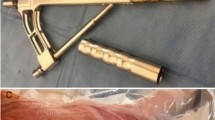Abstract
The influence of threee different fixation devices on late healing complications after femoral neck fractures was studied in a large patient group from three different hospitals. Except for the choice of device, which was unique to each hospital, all other factors having a potential influence on the late outcome, such as sex and age of the patients, initial degree of fracture dislocation and quality of surgical reduction were similar among the three groups. Within a 2-year observation period the incidence of late segmental collapses (14%–19%) was not related to choice of device, but a higher number of non-unions (27%–30%) occurred after adaptive non-rigid methods using screws (von Bahr) or a flanged nail (Rydell) than after a more rigid osteosynthesis (8%, Deyerle). Using such a rigid fixation, the complication rate could be reduced by one-third and the need for revision surgery halved. A device providing stable fixation should be preferred for treatment of femoral neck fractures in the elderly to prevent the healing complications related to insufficient stabilization.
Similar content being viewed by others
References
Alberts KA; Jervaeus J (1990) Factors predisposing to healing complications after internal fixation of femoral neck fracture. A stepwise logistic regression analysis. Clin Orthop 257:129–133
Alho A, Benterud JG, Rönningen H, Höiseth A (1991) Radiographic prediction of early failure in femoral neck fracture. Acta Orthop Scand 62:422–426
Deyerle WM (1980) Impacted fixation over resilient multiple pins. Clin Orthop 152:102–122
Frandsen PA, Andersen PE (1981) Treatment of displaced fractures of the femoral neck. Smith-Petersen osteosynthesis versus sliding-nail-plate osteosynthesis. Acta Orthop Scand 52:547–552
Garden RS (1971) Malreduction and avascular necrosis in subcapital fractures of the femor. J Bone Joint Surg [Br] 53:183–197
Holmberg S, Kalen R, Thorngren KG (1987) Treatment and outcome of femoral neck fractures. An analysis of 2418 patients admitted from their own homes. Clin Orthop 218:42–52
Kofoed H, Alberts A (1980) Femoral neck fractures. 165 cases treated by multiple percutaneous pinning. Acta Orthop Scand 51:127–136
Nilsson LT, Strömquist B, Thorngren KG (1988) Nailing of femoral neck fracture. Clinical and sociologic 5-year follow-up of 510 consecutive hips. Acta Orthop Scand 59:365–371
Nilsson LT, Johansson Å, Strömgvist B (1993) Factors predicting healing complications in femoral neck fractures. 138 patients followed for 2 years. Acta Orthop Scand 64:175–177
Rydell N (1964) Osteosynthesis of medial collum fractures with the “spring-loaded nail”. Acta Orthop Scand 35:149–157
Strömgvist B, Hansson LI (1983) Avascular necrosis associated with nailing of femoral neck fracture. Acta Orthop Scand 54:687–694
Strömquist B, Hansson LI, Nilsson LT, Thorngren KG (1984) Two-year follow-up of femoral neck fractures. Comparisons of osteosynthesis methods. Acta Orthop Scand 55:521–525
Strömqvist B, Hansson LI, Nilsson LT, Thorngren KG (1987) Hook-pin fixation in femoral neck fractures. A two-year follow-up study of 300 cases. Clin Orthop 218:58–62
Strömgvist B, Nilsson LT, Thorngren KG (1992) Femoral neck fracture fixation with hook-pins. 2-year results and learning curve in 626 prospective cases. Acta Orthop Scand 63:282–287
Svenningsen S, Benum P, Nesse O, Furset OI (1984) Internal fixation of femoral neck fractures. Compression screw compared with nail plate fixation. Acta Orthop Scand 55:423–429
Thorling J, Edholm P (1981) Methods for assessing fixation and residual angulation in intracapsular hip fractures. Acta Radiol 22:441–447
Von Bahr V, Syk B, Walheim G (1974) Osteosynthesis of femoral neck fracture using screws. Acta Chir Scand 140:277–282
Author information
Authors and Affiliations
Rights and permissions
About this article
Cite this article
Hernefalk, L., Messner, K. Rigid osteosynthesis decreases the late complication rate after femoral neck fracture. Arch Orthop Trauma Surg 115, 71–74 (1996). https://doi.org/10.1007/BF00573444
Received:
Issue Date:
DOI: https://doi.org/10.1007/BF00573444




